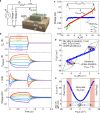Antiferroelectric negative capacitance from a structural phase transition in zirconia
- PMID: 35264570
- PMCID: PMC8907358
- DOI: 10.1038/s41467-022-28860-1
Antiferroelectric negative capacitance from a structural phase transition in zirconia
Abstract
Crystalline materials with broken inversion symmetry can exhibit a spontaneous electric polarization, which originates from a microscopic electric dipole moment. Long-range polar or anti-polar order of such permanent dipoles gives rise to ferroelectricity or antiferroelectricity, respectively. However, the recently discovered antiferroelectrics of fluorite structure (HfO2 and ZrO2) are different: A non-polar phase transforms into a polar phase by spontaneous inversion symmetry breaking upon the application of an electric field. Here, we show that this structural transition in antiferroelectric ZrO2 gives rise to a negative capacitance, which is promising for overcoming the fundamental limits of energy efficiency in electronics. Our findings provide insight into the thermodynamically forbidden region of the antiferroelectric transition in ZrO2 and extend the concept of negative capacitance beyond ferroelectricity. This shows that negative capacitance is a more general phenomenon than previously thought and can be expected in a much broader range of materials exhibiting structural phase transitions.
© 2022. The Author(s).
Conflict of interest statement
The authors declare no competing interests.
Figures




Similar articles
-
Fluorite-structure antiferroelectrics.Rep Prog Phys. 2019 Dec;82(12):124502. doi: 10.1088/1361-6633/ab49d6. Epub 2019 Oct 1. Rep Prog Phys. 2019. PMID: 31574497
-
Ferroelectricity in Orthorhombic Zirconia Thin Films.Nano Lett. 2025 Mar 19;25(11):4220-4226. doi: 10.1021/acs.nanolett.4c05612. Epub 2025 Mar 6. Nano Lett. 2025. PMID: 40048556
-
Boosting Inversion Symmetry Breaking in Epitaxial Tetragonal ZrO2 Via Atomic Layer Deposition.Nano Lett. 2025 Jul 30;25(30):11673-11679. doi: 10.1021/acs.nanolett.5c02741. Epub 2025 Jul 18. Nano Lett. 2025. PMID: 40679869 Free PMC article.
-
Why Do Ferroelectrics Exhibit Negative Capacitance?Materials (Basel). 2019 Nov 13;12(22):3743. doi: 10.3390/ma12223743. Materials (Basel). 2019. PMID: 31766263 Free PMC article. Review.
-
Structural Phase Transition and In-Situ Energy Storage Pathway in Nonpolar Materials: A Review.Materials (Basel). 2021 Dec 18;14(24):7854. doi: 10.3390/ma14247854. Materials (Basel). 2021. PMID: 34947446 Free PMC article. Review.
Cited by
-
Local orthorhombic phase in zirconium oxide nanocrystals: insights from X-ray pair distribution function analysis.J Appl Crystallogr. 2025 Apr 4;58(Pt 3):688-695. doi: 10.1107/S1600576725001761. eCollection 2025 Jun 1. J Appl Crystallogr. 2025. PMID: 40475928 Free PMC article.
-
Ideal antiferroelectricity with large digital electrostrain in PbZrO3 epitaxial thin films.Nat Commun. 2025 May 8;16(1):4263. doi: 10.1038/s41467-025-59598-1. Nat Commun. 2025. PMID: 40335517 Free PMC article.
-
Giant energy storage and power density negative capacitance superlattices.Nature. 2024 May;629(8013):803-809. doi: 10.1038/s41586-024-07365-5. Epub 2024 Apr 9. Nature. 2024. PMID: 38593860
References
-
- Patel S, Chauhan A, Vaish R. A technique for giant mechanical energy harvesting using ferroelectric/antiferroelectric materials. J. Appl. Phys. 2014;115:084908.
-
- Park MH, et al. Toward a multifunctional monolithic device based on pyroelectricity and the electrocaloric effect of thin antiferroelectric HfxZr1−xO2 films. Nano Energy. 2015;12:131–140.
-
- Xua B, Cross LE, Bernstein JJ. Ferroelectric and antiferroelectric films for microelectromechanical systems applications. Thin Solid Films. 2000;377-378:712–718.
-
- Wang H, Liu Y, Yang T, Zhang S. Ultrahigh energy‐storage density in antiferroelectric ceramics with field‐induced multiphase transitions. Adv. Funct. Mater. 2019;29:1807321.
Grants and funding
- ECCS-1542174/National Science Foundation (NSF)
- FA9550-16-1-0335/United States Department of Defense | United States Air Force | AFMC | Air Force Office of Scientific Research (AF Office of Scientific Research)
- CZ.02.1.01/0.0/0.0/15\_003/0000485/EC | European Regional Development Fund (Europski Fond za Regionalni Razvoj)
- 11180590/Fondo Nacional de Desarrollo Científico y Tecnológico (National Fund for Scientific and Technological Development)

